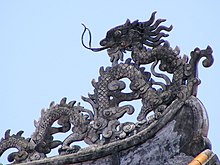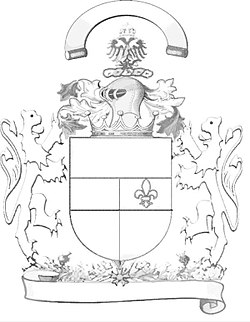Legendary creature
 |
| Speculative fiction |
|---|
Alternate history
|
Fantasy fiction
|
Science fiction
|
Horror fiction
|
Miscellaneous
|

In classical mythology, the Minotaur was defeated by the hero Theseus.
A legendary, mythical, or mythological creature, traditionally called a fabulous beast or fabulous creature, is a fictitious, imaginary and often supernatural animal, often a hybrid, sometimes part human, whose existence has not or cannot be proved and that is described in folklore or fiction but also in historical accounts before history became a science.
In the classical era, monstrous creatures such as the cyclops and the Minotaur appear in heroic tales for the protagonist to destroy. Other creatures, such as the unicorn, were claimed in accounts of natural history by various scholars of antiquity.[1][2][3] Some legendary creatures have their origin in traditional mythology and were believed to be real creatures, for example dragons, griffins, and unicorns. Others were based on real encounters, originating in garbled accounts of travelers' tales, such as the Vegetable Lamb of Tartary, which supposedly grew tethered to the earth.[4]
Contents
1 Animals
2 Allegory
3 See also
4 References
5 External links
Animals

Medieval bestiaries included mythical animals like the monoceros (above) alongside real animals like the bear.
A variety of mythical animals appear in the art and stories of the Classical era. For example in the Odyssey, monstrous creatures include the Cyclops, Scylla and Charybdis for the hero Odysseus to confront. In other tales there appear the Medusa to be defeated by Perseus, the (human/bull) Minotaur to be destroyed by Theseus, and the Hydra to be killed by Heracles, while Aeneas battles with the harpies. These monsters thus have the basic function of emphasizing the greatness of the heroes involved.[5][6][7]
Some classical era creatures, such as the (horse/human) centaur, chimaera, Triton and the flying horse, are found also in Indian art. Similarly, sphinxes appear as winged lions in Indian art and the Piasa Bird of North America.[8][9]
In medieval art, animals, both real and mythical, played important roles. These included decorative forms as in medieval jewellery, sometimes with their limbs intricately interlaced. Animal forms were used to add humor or majesty to objects. In Christian art, animals carried symbolic meanings, where for example the lamb symbolized Christ, a dove indicated the Holy Spirit, and the classical griffin represented a guardian of the dead. Medieval bestiaries included animals regardless of biological reality; the basilisk represented the devil, while the manticore symbolised temptation.[10]
Allegory

Symbolic power: a dragon in the Imperial City, Huế, Vietnam
One function of mythical animals in the Middle Ages was allegory. Unicorns, for example, were described as extraordinarily swift and uncatchable by traditional methods.[11]:127 It was believed that the only way for one to catch this beast was to lead a virgin to its dwelling. Then, the unicorn was supposed to leap into her lap and go to sleep, at which point a hunter could finally capture it.[11]:127 In terms of symbolism, the unicorn was a metaphor for Christ. Unicorns represented the idea of innocence and purity. In the King James Bible, Psalm 92:10 states, "My horn shalt thou exalt like the horn of an unicorn." This is because the translators of the King James erroneously translated the Hebrew word re'em as unicorn.[11]:128 Later versions translate this as wild ox.[12] The unicorn's small size signifies the humility of Christ.[11]:128
Another common legendary creature which served allegorical functions within the Middle Ages was the dragon. Dragons were identified with serpents, though their attributes were greatly intensified. The dragon was supposed to have been larger than all other animals.[11]:126 It was believed that the dragon had no harmful poison but was able to slay anything it embraced without any need for venom. Biblical scriptures speak of the dragon in reference to the devil, and they were used to denote sin in general during the Middle Ages.[11]:126 Dragons were said to have dwelled in places like Ethiopia and India, based on the idea that there was always heat present in these locations.[11]:126
Physical detail was not the central focus of the artists depicting such animals, and medieval bestiaries were not conceived as biological categorizations. Creatures like the unicorn and griffin were not categorized in a separate "mythological" section in medieval bestiaries,[13]:124 as the symbolic implications were of primary importance. Animals we know to have existed were still presented with a fantastical approach. It seems the religious and moral implications of animals were far more significant than matching a physical likeness in these renderings. Nona C. Flores explains, "By the tenth century, artists were increasingly bound by allegorical interpretation, and abandoned naturalistic depictions."[13]:15 Similarly, the historian Richard Kieckhefer explains, "Magic is not meant to work but to express wishes, or to encode in symbols a perception of how things do or should work."[14]
See also
- Cryptozoology
- Lists of legendary creatures
- List of legendary creatures by type
References
^ The Encyclopædia Britannica: A Dictionary of Arts, Sciences, Literature and General Information. University Press. 1911. p. 581..mw-parser-output cite.citationfont-style:inherit.mw-parser-output qquotes:"""""""'""'".mw-parser-output code.cs1-codecolor:inherit;background:inherit;border:inherit;padding:inherit.mw-parser-output .cs1-lock-free abackground:url("//upload.wikimedia.org/wikipedia/commons/thumb/6/65/Lock-green.svg/9px-Lock-green.svg.png")no-repeat;background-position:right .1em center.mw-parser-output .cs1-lock-limited a,.mw-parser-output .cs1-lock-registration abackground:url("//upload.wikimedia.org/wikipedia/commons/thumb/d/d6/Lock-gray-alt-2.svg/9px-Lock-gray-alt-2.svg.png")no-repeat;background-position:right .1em center.mw-parser-output .cs1-lock-subscription abackground:url("//upload.wikimedia.org/wikipedia/commons/thumb/a/aa/Lock-red-alt-2.svg/9px-Lock-red-alt-2.svg.png")no-repeat;background-position:right .1em center.mw-parser-output .cs1-subscription,.mw-parser-output .cs1-registrationcolor:#555.mw-parser-output .cs1-subscription span,.mw-parser-output .cs1-registration spanborder-bottom:1px dotted;cursor:help.mw-parser-output .cs1-hidden-errordisplay:none;font-size:100%.mw-parser-output .cs1-visible-errorfont-size:100%.mw-parser-output .cs1-subscription,.mw-parser-output .cs1-registration,.mw-parser-output .cs1-formatfont-size:95%.mw-parser-output .cs1-kern-left,.mw-parser-output .cs1-kern-wl-leftpadding-left:0.2em.mw-parser-output .cs1-kern-right,.mw-parser-output .cs1-kern-wl-rightpadding-right:0.2em
^ Bascom, William (1984). Alan Dundes, ed. Sacred Narrative: Readings in the Theory of Myth. University of California Press. p. 9. ISBN 9780520051928.
^ Simpson, Jacqueline; Roud, Steve (2000). A Dictionary of English Folklore. Oxford University Press. ISBN 9780192100191. Retrieved 24 March 2013.
^ Large, Mark F.; John E. Braggins (2004). Tree Ferns. Portland, Oregon: Timber Press, Incorporated. p. 360. ISBN 978-0-88192-630-9.
^ Delahoyde, M.; McCartney, Katherine S. "Monsters in Classical Mythology". Washington State University. Retrieved 6 January 2017.
^ Grimal, Pierre. The Dictionary of Classical Mythology. Blackwell Reference, 1986.
^ Sabin, Frances E. Classical Myths That Live Today. Silver Burdett Company, 1940.
^ Murthy, K. Krishna (1985). Mythical Animals in Indian Art. Abhinav Publications. pp. 68–69. ISBN 978-0-391-03287-3.
^ O'Flaherty, Wendy (1975). Hindu Myths: A Sourcebook. Penguin.
^ Boehm, Barbara Drake; Holcomb, Melanie (January 2012) [2001]. "Animals in Medieval Art". Metropolitan Museum of Art. Retrieved 5 January 2017.CS1 maint: Multiple names: authors list (link)
^ abcdefg Gravestock, Pamela. "Did Imaginary Animals Exist?" In The Mark of the Beast: The Medieval Bestiary in Art, Life, and Literature. New York: Garland. 1999.
^ J. L. Schrader. The Metropolitan Museum of Art Bulletin, New Series, Vol. 44, No. 1, "A Medieval Bestiary" (Summer, 1986), pp. 1+12–55, 17.
^ ab Flores, Nona C., "The Mirror of Nature Distorted: The Medieval Artist's Dilemma in Depicting Animals". In The Medieval World of Nature. New York: Garland. 1993.
^ Kieckhefer, Richard. "The Specific Rationality of Medieval Magic". In The American Historical Review, Vol. 99, Issue 3, 813-836. 1994, 814.
| Wikimedia Commons has media related to Legendary creatures. |
External links
Mythical creature in the New World Encyclopedia


